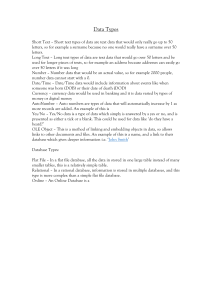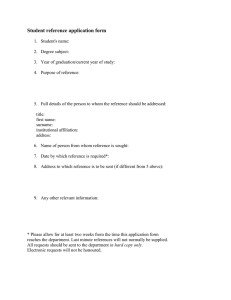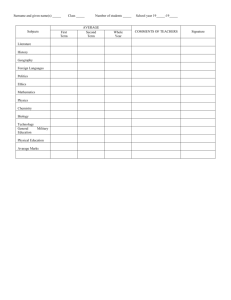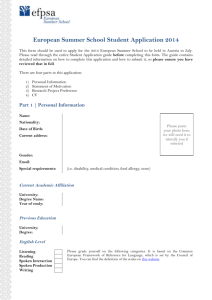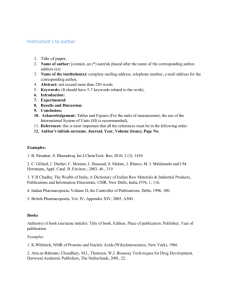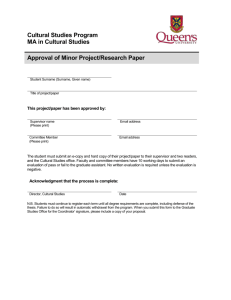JCEU- Template-2014
advertisement
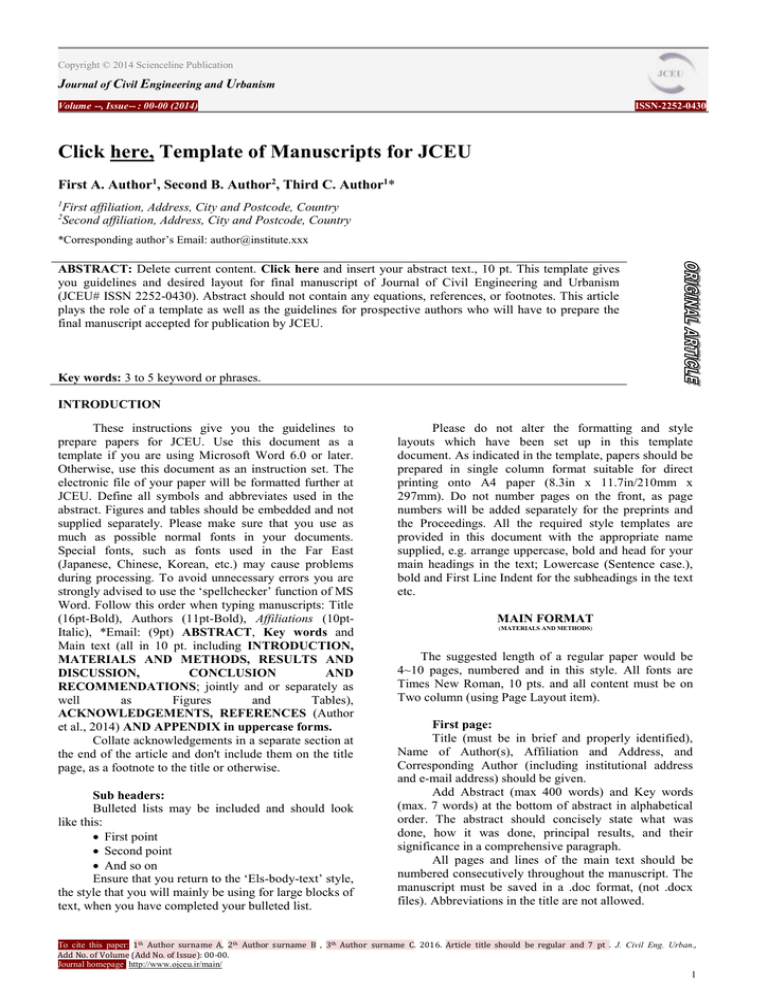
Copyright © 2014 Scienceline Publication Journal of Civil Engineering and Urbanism Volume --, Issue-- : 00-00 (2014) ISSN-2252-0430 Click here, Template of Manuscripts for JCEU First A. Author1, Second B. Author2, Third C. Author1* 1 First affiliation, Address, City and Postcode, Country Second affiliation, Address, City and Postcode, Country 2 *Corresponding author’s Email: author@institute.xxx ABSTRACT: Delete current content. Click here and insert your abstract text., 10 pt. This template gives you guidelines and desired layout for final manuscript of Journal of Civil Engineering and Urbanism (JCEU# ISSN 2252-0430). Abstract should not contain any equations, references, or footnotes. This article plays the role of a template as well as the guidelines for prospective authors who will have to prepare the final manuscript accepted for publication by JCEU. Key words: 3 to 5 keyword or phrases. INTRODUCTION These instructions give you the guidelines to prepare papers for JCEU. Use this document as a template if you are using Microsoft Word 6.0 or later. Otherwise, use this document as an instruction set. The electronic file of your paper will be formatted further at JCEU. Define all symbols and abbreviates used in the abstract. Figures and tables should be embedded and not supplied separately. Please make sure that you use as much as possible normal fonts in your documents. Special fonts, such as fonts used in the Far East (Japanese, Chinese, Korean, etc.) may cause problems during processing. To avoid unnecessary errors you are strongly advised to use the ‘spellchecker’ function of MS Word. Follow this order when typing manuscripts: Title (16pt-Bold), Authors (11pt-Bold), Affiliations (10ptItalic), *Email: (9pt) ABSTRACT, Key words and Main text (all in 10 pt. including INTRODUCTION, MATERIALS AND METHODS, RESULTS AND DISCUSSION, CONCLUSION AND RECOMMENDATIONS; jointly and or separately as well as Figures and Tables), ACKNOWLEDGEMENTS, REFERENCES (Author et al., 2014) AND APPENDIX in uppercase forms. Collate acknowledgements in a separate section at the end of the article and don't include them on the title page, as a footnote to the title or otherwise. Sub headers: Bulleted lists may be included and should look like this: First point Second point And so on Ensure that you return to the ‘Els-body-text’ style, the style that you will mainly be using for large blocks of text, when you have completed your bulleted list. Please do not alter the formatting and style layouts which have been set up in this template document. As indicated in the template, papers should be prepared in single column format suitable for direct printing onto A4 paper (8.3in x 11.7in/210mm x 297mm). Do not number pages on the front, as page numbers will be added separately for the preprints and the Proceedings. All the required style templates are provided in this document with the appropriate name supplied, e.g. arrange uppercase, bold and head for your main headings in the text; Lowercase (Sentence case.), bold and First Line Indent for the subheadings in the text etc. MAIN FORMAT (MATERIALS AND METHODS) The suggested length of a regular paper would be 4~10 pages, numbered and in this style. All fonts are Times New Roman, 10 pts. and all content must be on Two column (using Page Layout item). First page: Title (must be in brief and properly identified), Name of Author(s), Affiliation and Address, and Corresponding Author (including institutional address and e-mail address) should be given. Add Abstract (max 400 words) and Key words (max. 7 words) at the bottom of abstract in alphabetical order. The abstract should concisely state what was done, how it was done, principal results, and their significance in a comprehensive paragraph. All pages and lines of the main text should be numbered consecutively throughout the manuscript. The manuscript must be saved in a .doc format, (not .docx files). Abbreviations in the title are not allowed. To cite this paper: 1th Author surname A, 2th Author surname B , 3th Author surname C. 2016. Article title should be regular and 7 pt . J. Civil Eng. Urban., Add No. of Volume (Add No. of Issue): 00-00. Journal homepage: http://www.ojceu.ir/main/ 1 Table 1. An example of table PRESENTATION OF THE ARTICLE Article Sections Format: Title: Title should be a brief phrase describing the contents of the paper. The Title Page should include the author(s)'s full names and affiliations, the name of the corresponding author along with phone e-mail information and present address (es) of author(s). Abstract: Abstract should be informative and completely self-explanatory, briefly present the topic, state the scope of the experiments, indicate significant data, and point out major findings and conclusions. The abstract should be 150 to 300 words in length with in font size of 10 pt. Complete sentences, active verbs, and the third person should be used, and the abstract should be written in the past tense. Standard nomenclature should be used and abbreviations should be avoided. No literature should be cited. Key words: Following the abstract, about 3 to 10 key words that will provide indexing references should be listed. Introduction: Introduction should provide a clear statement of the problem, the relevant literature on the subject, and the proposed approach or solution. It should be understandable to colleagues from a broad range of scientific disciplines. Materials and Methods: Materials and Methods should be complete enough to allow experiments to be reproduced. However, only truly new procedures should be described in detail; previously published procedures should be cited, and important modifications of published procedures should be mentioned briefly. Capitalize trade names and include the manufacturer's name and address. Subheadings should be used. Methods in general use need not be described in detail. Results: Results should be presented with clarity and precision. The results should be written in the past tense when describing findings in the author(s)'s experiments. Previously published findings should be written in the present tense. Results should be explained, but largely without referring to the literature. Discussion, speculation and detailed interpretation of data should not be included in the results but should be put into the discussion section. Discussion: Discussion should interpret the findings in view of the results obtained in this and in past studies on this topic. State the conclusions in a few sentences at the end of the paper. The Results and Discussion sections can include subheadings, and when appropriate, both sections can be combined if preferred. Acknowledgments: Acknowledgments of persons, grants, funds, etc should be brief. Tables: Tables should be kept to a minimum and be designed to be as simple as possible. Tables are to be typed double-spaced throughout, including headings and footnotes. Each table should be on a separate page, numbered consecutively in Arabic numerals and supplied with a heading and a legend. Tables should be self-explanatory without reference to the text. The details of the methods used in the experiments should preferably be described in the legend instead of in the text. The same data should not be presented in both table and graph forms or repeated in the text. An example of a column heading Column A (kg) Column B (dl) Column C (n=35) And an entry 1 2 5.5 And another entry 1 3 4 6.5 And another entry 5 6 7.5 a,b,c,d; Means within a column with different superscripts differ significantly (P<0.05). 1 For each word or item that are required to explanation. *P < 0.05; ** P < 0.01; *** P < 0.001; NS = not significant Graph1. Tables are numbered with Roman numerals. Please do not include captions as part of the figures. 6 5 4 Series 3 Series 2 Series 1 Footnotes: *P<0.05 0 Category 1Category 3Category 4 Figure: Figure legends2Category should be typed in numerical order on a separate sheet. Graphics should be prepared using applications capable of generating high resolution GIF, TIFF, JPEG or PowerPoint before pasting in the Microsoft Word manuscript file. Use Arabic numerals to designate figures and upper case letters for their parts (Figure 1). Begin each legend with a title and include sufficient description so that the figure is understandable without reading the text of the manuscript. Information given in legends should not be repeated in the text. Figure 1. first picture CONCLUSION Even though a conclusion may review the main results or contributions of the paper, do not duplicate the abstract or the introduction. For a conclusion, you might elaborate on the importance of the work or suggest the potential applications and extensions. Appendix Appendixes, if acknowledgment. needed, appear before the Acknowledgements To cite this paper: 1th Author surname A, 2th Author surname B , 3th Author surname C. 2016. Article title should be regular and 7 pt . J. Civil Eng. Urban., Add No. of Volume (Add No. of Issue): 00-00. Journal homepage: http://www.ojceu.ir/main/ 2 This work was supported by … REFERENCES In the text, a reference identified by means of an author‘s name should be followed by the date of the reference in parentheses. When there are more than two authors, only the first author‘s name should be mentioned, followed by ’et al‘. In the event that an author cited has had two or more works published during the same year, the reference, both in the text and in the reference list, should be identified by a lower case letter like ’a‘ and ’b‘ after the date to distinguish the works. All the cited papers in the text must be listed in References. All the papers in References must be cited in the text - Examples (at the text): Abayomi (2000), Agindotan et al. (2003), (Kelebeni, 1983), (Usman and Smith, 1992), (Chege, 1998; Chukwura, 1987a,b;Tijani, 1993,1995), (Kumasi et al., 2001). - Examples (at the end of manuscript, References section): Barabasi AL, Ravasz E, Vicsek T. (2001). Deterministic scale-free networks. Physica A, 299: 559-564. Barabasi AL. (2009). Scale free networks: a decade and beyond. Science, 325: 412-413. Mehrotra P. (1988). Adaptive significance of leaf in relation to other parts in oak forest herbs of Kumaun Himalaya, Ph. D. Thesis, Kumaun University, Nainital, India Tangpagasit J, Cheerarot R, Jaturapitakkul C, Kiattikomol K. (2005). Packing effect and pozzolanic reaction of fly ash in mortar. Cement and Concrete Research, 35: 1145– 1151. Zhang Z, Virrantaus K. (2010). Analysis of vulnerability of road networks on the basis of graph topology and related attribute information. 13th AGILE International Conference on Geographic Information Science, 1-4 Guimarães, Portugal. To cite this paper: 1th Author surname A, 2th Author surname B , 3th Author surname C. 2016. Article title should be regular and 7 pt . J. Civil Eng. Urban., Add No. of Volume (Add No. of Issue): 00-00. Journal homepage: http://www.ojceu.ir/main/ 3
